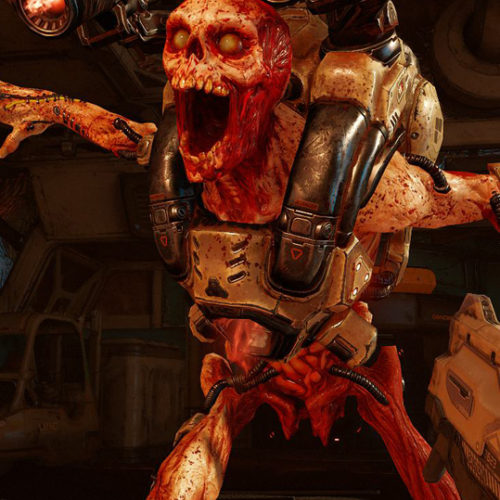It’s all gone to Hell in a headset.
After having a bit of a rough time with Bethesda’s recent VR outing, Skyrim VR, I was slightly worried about how they would handle one of last year’s best games, Doom. Turns out, I shouldn’t have been too concerned.
Let me start with the first thing that you will notice about Doom VFR (Very clever Bethesda) is that unlike Skyrim VR, this isn’t just the 2016 version of the game crammed into a headset. Doom VFR is a whole new story, albeit one that doesn’t put you in the boots of the Doomslayer. You are the last surviving human on Mars; that is until you are ripped to shreds in the opening minute. Whoops. Luckily, the UAC computer system extracts your brain data just before your death and transfers it into an AI. Quite quickly players will learn that there is a new hole to hell that needs to closed in order to stop the hordes of demons from invading our universe.

Platforms: HTC Vive, PlayStation VR (Reviewed)
Price: $29.99
Controller Support: Move, DualShock 4 and Aim
Price I’d pay: $29.99
The story isn’t very original or exciting; it is just a method of creating agency for the player and a way to get from point A to point B to point C. It is the stuff in between that matters; the demon slaying. Inserted into an artificial body, our hero must travel from area to area, completing tasks and solving a few puzzles and firing weapons. The first time players take control, the game will take them through an extensive tutorial, allowing them to get to grips with how the controls and mechanics work. Whether I chose to use a DualShock 4 or Move controllers, the controls worked in an almost identical ways and the tutorial did a great job.
Along with moving and shooting, Doom VFR allows quick bursts in four directions, great for getting out of the way of those pesky fireballs. Players may experience a few issues when it comes to finding their bearings, as I did; but it never really detracted from my enjoyment. The circle button also fires off a shock wave that will push back any demons that are crowding around, which is handy if players get a little overwhelmed. As one would expect, Doom VFR is nowhere near as fast paced as Doom 2016, and it shouldn’t be as that kind of speed would only end in a bout of motion sickness. The teleportation system works super well here, and when pressing the button to move, time slows down allowing a small window of time to plan out the next kill. Teleportation is also how players perform the slay kills. Much like its bigger brother, if I shot a demon almost to death, it would glow blue. I would then have a brief window of time to teleport over and smash them to pieces. However, these kills are not animated in the same way, I just teleport over and the demons would explode. It’s cool, but I didn’t get the same satisfaction as I did from Doom. The game also supports the Aim Controller, the one that came packed in with the game Farpoint. But I cannot tell you how the controls play with it, as I don’t have one.
There is also a lot of teleporting to do in between fights. The map is big; starting in the Mars UAC base, and then ending up in Hell, players will find themselves using the teleportation button a lot. It isn’t that bad, but can get a little repetitive. Don’t worry though, when the fights do kick off, that is where Doom VFR really stands out. Bethesda seems to have squeezed every bit of juice out of the PlayStation VR. Visuals are sharp, even when the action gets heavy, and it really did raise my heart rate when locked in an area with several demons of various shapes and sizes all chasing after me.
Some of the larger beasts are truly scary, and I felt like a tiny, puny human when I got up close and personal. The weapon selection on offer is the same found in Doom, although they did feel a little more real being in VR. These weapons are dished out quite quickly and of course can be upgraded at work stations; as can players’ stats. Health and ammo capacity are both upgradable but with a third being added that improves your teleportation ability. The decision as to which one to upgrade will be yours at each station; but only one can be upgraded at a time.

There are some light puzzles to solve to unlock certain areas, these are timing based and don’t prove too difficult. It just adds a little something different to the mix and can be a welcome distraction after a particularly heavy firefight. Players will also find themselves interacting with the base’s systems and UI; which looks cool in VR. There is also a visual compendium in the main area that not only brings people up to speed with the story so far, but also allows them to handle some 3D models of the demons and main players in the Doom universe. It’s a fantastic addition and the 3D models look amazing in VR.
I was really surprised at how much I enjoyed my time with Doom VFR. Skyrim VR had soured me a little and I wasn’t really looking forward to playing. But this shows that rethinking how a game will work in VR, instead of just shoehorning a game into VR wholesale, can make the world of difference. It also helps that the game has a price tag to match.
Review copy of game provided by publisher.
